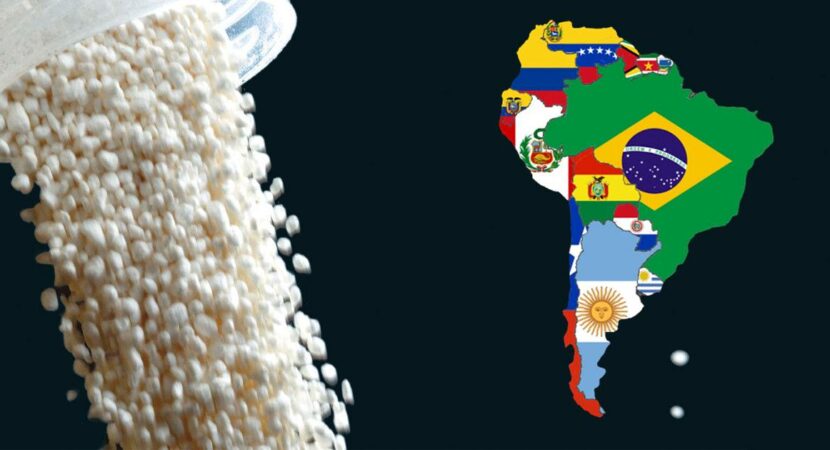
Latin America should start 2021 with optimism about the coronavirus pandemic, as the scientific community signals that vaccines could be ready faster than expected.
The region was one of the most affected during the first half of 2020 and had a rapid recovery in the second half of the year, a trend that should continue in the first half of 2021.
The pandemic surprised all players, but the expected negative impacts on local economies were revised throughout the year, as governments took measures to mitigate the crisis. Plastic consumption is seeing strong demand entering the first 202 semester1, after recovering from an initial pullback.
The International Monetary Fund revised its estimate of Brazilian GDP growth in 2021 from 3,6% to 2,8%, after revising its estimates for 2020 from a drop from 9,1% to 5,8%. Other regional economies such as Argentina and Chile have seen stronger lockdown measures and slower economic recoveries, but are expected to enter 2021 with an improvement in consumption as industries return to pre-pandemic levels. The IMF estimates that Latin America's GDP will fall by 8,1% in 2020 and will grow by 3,6% in 2021.
These improved prospects can be seen in the Latin American polymer markets for the year ahead as well.
Market players believe that the automotive sector in Latin America can boost polypropylene consumption in 2021. In Brazil and Argentina, vehicle production levels are rising. have recovered since may and they normalized from August, while official associations avoided making forecasts for 2021. The sectors saw activity almost paralyzed in April amid widespread pauses to contain the spread of the coronavirus.
“Polypropylene prices will hold better than polyethylene but are expected to decline by $100/mt or more over the next six months,” said Robert Stier, senior leader petrochemicals at S&P Global Platts Analytics.
The Latin American construction sector also stalled at the start of the pandemic, but soon saw a strong recovery. The sector should boost the consumption of plastics throughout the first quarter with the resumption of infrastructure projects.
In 2021, petrochemical run rates and demand across the region are expected to see increases compared to 2020.
“We expect South American ethylene and polyethylene fundamentals to be very similar to 2019 with regard to plant operating rates and polyethylene net trade,” Stier said.
Higher demand, lower inventory
The industrial sector's struggle with raw material shortages was expected to extend into early 2021 before normalization. High demand in the second half of 2020 clashed with low resin stocks from distributors, leading to stronger prices for imported and domestic material across the region.
Polyethylene prices in Brazil and in import markets on the West Coast of South America are expected to decline in the first half of 2021, according to Stier, after falling since early November from historic highs in September and October.
“By June, polyethylene prices are expected to drop by as much as $200/mt from current high levels, which are a result of the global disruptions that began with Hurricane Laura in late August,” comments S&P Global's senior petrochemicals leader. Platts Analytics.
The polyethylene import markets of Brazil and the West Coast of South America showed a rapid V-shaped recovery, while prices lagged. Between May and June, prices hit record lows for both regions before skyrocketing to record levels.
Market participants see no room for increases in domestic polyethylene prices in Brazil in early 2021.
Polyethylene resins reached record domestic prices in Brazil in November, reflecting higher values in the import market and the sharp devaluation of the Brazilian currency, the Real.
Some players, however, were concerned that companies were still restocking inventories, possibly leading to a price rebound.
The expectation for 2021 is for more stable monetary values across the region, an important element to consider polymer imports.
The Central Bank of Brazil sees the exchange rate for the Real ending 2021 at R$5,20 / US$1 and, at the same time, the local annual interest rate rising by 1 percentage point, to 3% from the current 2%. The uncertainty of the pandemic made the Real one of the most devalued currencies in the world in 2020. The exchange rate started 2020 at R$ 4,01 / US$ 1, considered high at the time, but exceeded R$ 5,80 / $1 in the first half.
Brazil was not the only one to face currency devaluation. Argentina's currency devalued by more than 30% and Colombia's by more than 17%. Currencies in Chile and Peru were less affected.
In the Mercosur region, local distributors and traders believe that limited product availability may continue until January, while they expect the situation to be resolved soon as extra-zone materials are gaining market share. The region was mainly supplied by regional producers from Brazil and Argentina; high prices weren't the issue as availability became nil during the second half of 2020.
*Review from the perspective of Global Platts experts













Air Force F-16 fighters…
True friend, what they shot down were…
Air Force F-16 fighters…
I would like to know what planet you live on…
Air Force F-16 fighters…
Everything is fine, 100-year secrecy,…
Air Force F-16 fighters…
Well... It's flying scrap... Typical...
Air Force F-16 fighters…
Which genocide are you talking about? Than…
DEUS me livre, vergonha desse exército, que…
Good afternoon, I saw this competition announcement…
If it's true it would be really good
Go for it, that’s how I lived in…
enrollment
I'm a Mig Mag tubular wire welder too...
I am a building technician, bricklayer, tile worker, painter…
They buy from China and put the…